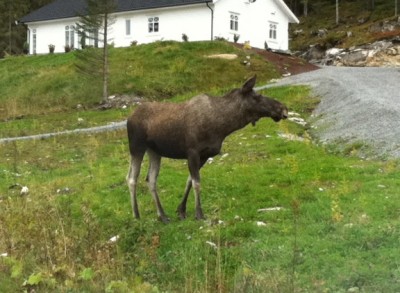The mighty moose, known as elg in Norwegian, have become so dominant in the forests of Norway that they’ve taken over cattle’s role as the most influential grazing animals. That’s causing major vegetation changes in the uncultivated areas called utmark, according to local researchers.

For the past five decades, researchers from the Norwegian Institute for Nature Research (NINA), the University of Oslo and the Norwegian University of Science and Technology (NTNU) in Trondheim have studied the changes in grazing pressure on open lands around Norwegian townships. Their results are being published in the magazine Wildlife Biology, and show that the changes are both major and visible in the terrain.
Until just after the war, Norwegian ranchers actively used uncultivated areas as grazing land for their animals. Cattle, sheep, goats and horses were released during the summer months, and the population of moose, deer and elk was relatively small.
According to an article on the research website forskning.no, most cattle are now being kept in fenced-in areas or in barns, instead of being released for open grazing. Sheep ranchers are still sending their animals out for open grazing in the summer months, but often to the mountains instead of to local forests at lower elevations.
Both wild and tame animals influence what types of plants and grass grow, and now the researchers claim the moose have the most influence. The moose population has been growing for years while grazing livestock is on the decline: Fewer than 5,000 moose were shot during hunting seasons in the 1950s, while last year hunters could shoot around 36,000.
“Typical eastern Norwegian forests in 1949 had a lot of livestock,” senior researcher Gunnar Austrheim of NTNU’s science museum told forskning.no. “Moose was seldom seen.”
That’s changed and statistics now show that wild game including deer and especially moose are eating more of the forest vegetation than livestock. Researchers call that an historic shift, not least because moose and cattle eat different vegetation. Cattle and horses prefer grass and wildflowers, and their absence means many such open areas have been taken over by forest again. Moose munch on twigs and bark from trees and thus renew the forest at the same time.
That’s yielded more heather and what researchers call “typical forest landscapes,” and less open grassy areas. Austrheim said the biggest decline in livestock grazing occurred in the 1960s, providing more food for wild game and boosting their population. He urges more coordinated management of livestock and game, to better control the grazing impact on uncultivated areas.
Views and News from Norway/Nina Berglund
Please support our stories by clicking on the “Donate” button now:

